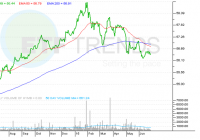Examining Your Fund’s Puerto Rico Exposure
Summary Puerto Rico is scaring investors on fresh default concerns. High-yield municipal bonds are fluctuating on the heightened risks. Focus on three high-yield muni ETFs. By Todd Shriber & Tom Lydon Greece or Puerto Rico, investors have their pick of default poison, but investors in fixed-income, exchange-traded and mutual funds would do well to monitor goings-on in Puerto Rico because the U.S. territory’s imminent default could affect some well-known municipal bond funds. So dire is the situation in Puerto Rico, Gov. Alejandro García Padilla told the New York Times over the weekend that government finances there are “in a death spiral.” And $72 billion is not chump change. To put $72 billion into context with a catchy anecdote, that is more than twice the market capitalization of General Mills (NYSE: GIS ). Puerto Rico’s debt woes are important to fund investors because an “estimated in 2013 that as much of 80% of Puerto Rico’s debt has found its way into muni-bond funds, and 180 mutual funds in the United States and elsewhere have at least 5% of their portfolios in Puerto Rican bonds,” Alan Gomez reports for USA Today , citing Morningstar data. “Last week, the general obligation (GO) debt had plumbed new depths, helping to record a negative 5% month-to-date return for the S&P Municipal Bond Puerto Rico General Obligation Index. According to JR Rieger, global head of fixed income for S&P Dow Jones Indices, the facts are the situation isn’t looking good: the pending Puerto Rico Electric Power Authority July 1st default looms on the market, the possible restructuring of the Government Development Bank debt and the possible postponement of G.O. set – asides have sent alarms to G.O. bond holders,” said S&P Capital IQ in a new research note. The $1.6 billion Market Vectors High-Yield Municipal Index ETF (NYSEARCA: HYD ) lost 1.4% Monday . That ETF has a Puerto Rico weight of just 3.2%, making the territory the fund’s tenth-largest geographic weight. The $396.8 million SPDR Nuveen S&P High Yield Municipal Bond ETF (NYSEARCA: HYMB ) lost just 0.8% yesterday despite a Puerto Rico weight of over 13%, making the territory HYMB’s largest geographic weight. The shorter-duration Market Vectors Short High-Yield Municipal Index ETF (NYSEARCA: SHYD ) was unchanged Monday even with a 4.5% weight Puerto Rican munis. Some actively-managed mutual funds have significantly larger Puerto Rico exposure than the ETF rivals. “Oppenheimer Rochester Fund Municipals (MUTF: RMUNX ), an actively managed mutual fund has 77% of its assets in NY state bonds, but most of the rest of the assets is in Puerto Rico bonds. Similarly Oppenheimer Rochester New Jersey Municipal Fund (MUTF: ONJAX ) has 29% of assets in bonds issued by Puerto Rico, despite what some New Jersey residents might expect,” according to S&P Capital IQ. SPDR Nuveen S&P High-Yield Municipal Bond ETF (click to enlarge) Tom Lydon’s clients own shares of HYD. Disclosure: I am/we are long HYD. (More…) I wrote this article myself, and it expresses my own opinions. I am not receiving compensation for it. I have no business relationship with any company whose stock is mentioned in this article.

